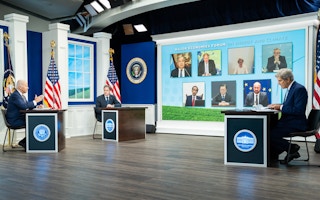Several climate and energy ministers will participate in informal discussions on clean energy goals this month as part of the Major Economies Forum (MEF) on Energy and Climate. The MEF has held a series of high-profile meetings in the past few months and will continue to do so as countries seek to engage in robust climate action after COP26 in Glasgow.
Back in April last year, US President Biden hosted the Leaders’ Summit on Climate, inviting 40 countries to announce new climate pledges that would drive momentum prior to COP26. During the summit, the Biden administration reconvened the MEF to collaborate with other countries on innovative climate solutions. The MEF has helped facilitate path-breaking climate diplomacy in the past.
The Biden administration aims to reconcile international climate diplomacy and domestic climate action so they mutually support each other. Climate diplomacy acts to catalyse domestic climate action while progress made in the domestic arena will enhance the credibility of international discussions and negotiations. At the intersection of these two approaches, the MEF will serve as a channel for the US to directly engage with major economies on climate action and harness positive domestic and international momentum.
The MEF has endured — in one form or another — over the last few administrations, playing an important but little recognised role within the international climate ecosystem. It started as the Major Economies Meeting (MEM) in 2009 during the George W Bush administration. A central idea behind it was that a smaller group of developing and developed countries, constituting the majority of the world’s emissions, would find it easier to reach a consensus on climate cooperation and generate the political leadership to advance negotiations under the UNFCCC (United Nations Framework Convention on Climate Change). During the Obama administration the MEM, re-named the MEF, played an important role in facilitating trust between the major emitters in the years preceding the Paris Agreement.
Top climate negotiators have found the MEF helpful in enabling climate diplomacy. Daniel A Reifsnyder, former deputy assistant secretary for environment in the US State Department, has said the MEF made possible frank conversations at very high levels. It provided a forum to make breakthroughs among key people and created new sets of expectations among them. Even if the breakthroughs were not written down, the new expectations provided informal means and ideas to discuss and find ways around problems. He said there was value in identifying different components to a problem and dealing with them in a creative manner, and the MEF provided opportunities to do that.
Specifically, the MEF provided an avenue for then US climate envoy Todd Stern and Chinese climate envoy Xie Zhenhua to meet and hold discussions before they had a more exclusive channel to do so through the “enhanced policy dialogue” component of the US-China Climate Change Working Group. It allowed for greater engagement between US and Indian bureaucrats before they further institutionalised their climate interactions through the US-India Joint Working Group on Combating Climate Change. It facilitated the US-Brazil Joint Statement on Climate Change. Overall, the MEF was a useful platform for shaping many of the bilateral climate deals between the US and emerging economies that laid the foundations for the Paris Agreement.
Discussions in the MEF on sectoral-based emissions have shaped climate negotiations in places such as the International Civil Aviation Authority (ICAO) and the Montreal Protocol on protecting the ozone layer. In the early stages of discussions, the MEF played a positive role in bringing key countries together to exchange ideas. After reaching the Paris Agreement in 2015, the US, China, India and the EU took advantage of global momentum by engaging in intense dialogue with one another and other major emitters in the MEF and other forums to reach the CORSIA Resolution to reduce aviation-related emissions and the Kigali Amendment to reduce HFC emissions.
The MEF was dormant for four years until the Biden administration picked it up and reconstituted it to play a more prominent role in the post-Paris climate architecture. Key themes of the Leaders’s Summit on Climate in April 2021 included “galvanizing” emission reductions efforts, “mobilising” finance, “spurring” transformational technologies, “showcasing” sub-national and non-state actors, and “discussing” opportunities. The summit was an example of an action-forcing event to push the ball forward after a long period of relative inaction. However, as an ad hoc event, it cannot sustain the long-term momentum necessary to develop the next set of nationally determined contributions to the Paris Agreement. The MEF can play that role, shaping the trajectory of future negotiations and discussions.
What’s next for the MEF?
In the coming months, the US will engage with other MEF members to launch action-oriented projects to reduce emissions in different sectors and other fields of activities. The Leaders’ Summit on Climate has already led to the announcement of joint international projects such as the establishment of a US-India Climate and Clean Energy Agenda 2030 Partnership, the launching of a Global Power System Transformation (G-PST) Consortium, the establishment of a Net-Zero Producers Forum and the launch of a Global Partnership for Climate-Smart Infrastructure, among other initiatives.
Another meeting of MEF in September 2021 led to new initiatives and action plans. Members offered support to the Global Methane Pledge, initiated by the US and EU to tackle methane emissions. They promised to raise their climate ambitions in the weeks leading to COP26 in Glasgow and continue these efforts after. Significantly, they made plans to leverage the MEF as a launchpad for efforts to scale up climate action in the coming decade. President Biden laid out plans to strengthen MEF’s role as a platform for launching future cooperative efforts such as the Global Methane Pledge. By focusing on sectoral decarbonisation as well as technology innovation and deployment, the MEF will aim to be at the core of multiple interlocking coalitions of cooperation dealing with various components of the wider climate action challenge.
The decarbonisation impact of the MEF will depend upon the institutional relationships that it sets up with other major forums in the international climate space. Progress made in the MEF can feed into initiatives such as Mission Innovation (MI) and the Clean Energy Ministerial (CEM) to ensure that innovations and clean energy technology are supported and scaled up to meet the challenges associated with decarbonisation. Likewise, these other forums can ensure the progress they make advances climate discussions and provides a springboard for further collaborative clean energy projects. The Biden administration has recognised this by offering to host the co-located 2022 MI and CEM meetings. Through these interlinked efforts, the MEF can serve as a major hub within the international climate action architecture.
In recent years, subnational governments and the private sector have played important roles in fostering momentum on climate action. As a potential institutional platform, the MEF need not confine its facilitative role to countries and can serve as a foundation for collaborations with these non-state actors to drive deep decarbonisation across various sectors. While the pathways for decarbonising the electricity and transportation sectors have become clearer, with existing technologies other sectors such as steel, cement, shipping and aviation remain resistant to significant carbon emissions abatement. By connecting and disseminating experimental solutions from various institutional nodes at different levels, the MEF can accelerate the progress needed to tackle decarbonisation in these challenging sectors.
For the MEF to endure, it will need to go beyond showcasing exclusive US leadership. It should be a place for the other members to engage in negotiations with one another. While the US could help to shepherd deals, it needs to create the space for other countries to engage in such collaboration. One strategy is for the US to create multiple coalitions with two or more other members of the MEF and then provide space for the other countries to either deepen their collaboration or branch out to other adjacent areas of cooperation. The MEF can be truly facilitative only when it acts as a springboard for further cooperation among the major emitters and beyond US engagement. This will allow it to remain relevant even if US leadership recedes as it did during the Trump administration.
An institution such as the MEF deals with paradoxes. It reconciles domestic and international action such that they support one another. It is a multilateral space that results in bilateral and “minilateral” deals that, in turn, lead to multilateral progress. It facilitates discussions that lead to action-oriented projects that will subsequently result in further conversations on meeting net-zero targets. The reconstituted MEF will now have an opportunity to meet these challenges and shape ambitious climate action within the broader climate architecture.
Giridharan Ramasubramanian is a PhD candidate in the Australian National University. He was a former Visiting Fellow in the Ostrom Workshop at Indiana University and a former Visiting Student Research Collaborator at Princeton University. This article was originally published on China Dialogue under a Creative Commons licence.









